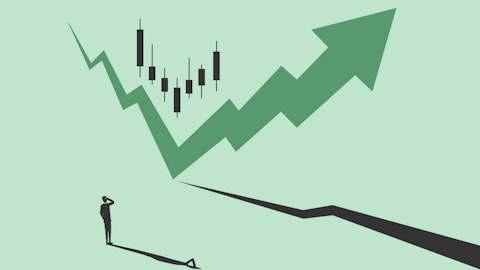Brookfield Infrastructure Partners L.P. (NYSE:BIP) Q4 2023 Earnings Call Transcript February 1, 2024
Brookfield Infrastructure Partners L.P. misses on earnings expectations. Reported EPS is $-0.17 EPS, expectations were $0.79. BIP isn’t one of the 30 most popular stocks among hedge funds at the end of the third quarter (see the details here).
Operator: Good day, and thank you for standing by. Welcome to the Brookfield Infrastructure Partners Fourth Quarter 2023 Results Conference Call. At this time, all participants are in a listen-only mode. After the speakers’ presentation, there will be a question-and-answer session. [Operator Instructions]. Please be advised that today’s conference is being recorded. I would now like to hand the conference over to your host today, David Krant, Chief Financial Officer. Please go ahead.
David Krant: Thank you, operator, and good morning, everyone. Welcome to Brookfield Infrastructure Partners fourth quarter 2023 earnings conference call. As introduced, my name is David Krant, and I’m the Chief Financial Officer of Brookfield Infrastructure. I’m joined today by our Chief Executive Officer, Sam Pollock; and our Chief Operating Officer, Ben Vaughan. I’ll begin the call today with a discussion of our 2023 financial and operating results, followed by some brief remarks on our access to capital and recent financing initiatives. I’ll then turn the call over to Ben, who will discuss the merits of investing boldly during periods of capital scarcity. Finally, Sam will provide an update on our recent acquisitions and will conclude with an outlook for the business.
At this time, I would like to remind you that in our remarks today, we may make forward-looking statements. These statements are subject to known and unknown risks, and future results may differ materially. For further information on known risk factors, I would encourage you to review our annual report on Form 20-F, which is available on our website. 2023 was another successful year for Brookfield Infrastructure. We executed many of our strategic priorities across all areas of our business. Some of our key accomplishments include closing over $2 billion of new investments, generating $1.9 billion of total proceeds from capital recycling, obtaining a second investment grade credit rating and maintaining our financial strength during a capital constrained year.
I’m also pleased to report that we exited 2023 on a high note with fourth quarter funds from operations of $0.79 per unit, a 10% increase over prior year levels. Considering these strong results and favorable outlook for 2024, the Board of Directors have approved a quarterly distribution increase of 6% to $1.62 per unit and share on an annualized basis. This marks the 15th consecutive year of distribution increases. I’ll now go through our annual results and discuss each of our business segments in more detail. Funds from operations totaled $2.3 billion an increase of 10% compared to 2022. Organic growth for the year was 8% reflecting strong levels of inflation in the countries where we operate, volume growth across the majority of our critical infrastructure networks and the commissioning of approximately $1 billion of new capital projects that are now contributing to earnings.
Taking a closer look at our results by segment. Our utilities businesses generated FFO of $879 million compared to $739 million in the prior year. This represents a 19% increase. This growth can be attributed to inflation indexation, which benefited our results by approximately 6% and the contribution associated with approximately $500 million of capital commissioned into our rate base. Results also benefited from the strong initial performance at HomeServe, which we privatized in January of 2023. Moving to our Transport segment. FFO was $888 million representing a 12% increase compared to the $794 million generated in the prior year. Base business results primarily benefited from inflationary tariff increases and higher volumes driven by strong economic activity around our networks.
In particular, our rail operations realized an average annual rate increase of 8% and volumes were up 2% from the previous year. At our diversified terminals, rates and volumes benefited from strong demand for bulk goods and commodities that underpin the global economy. And finally, our toll road portfolio realized annual traffic levels and tariff increases of 4% and 9% respectively compared to the prior year. Our results additionally benefited from the acquisition of Triton, our global intermodal logistics operation, which closed at the end of the third quarter and is performing ahead of expectations. Our Midstream segment, FFO totaled $684 million for the year. Results were impacted by the sale of one-third of our interest in a U.S. Gas Pipeline in June of 2023 as well as the normalization of market sensitive revenues at our diversified Canadian midstream business.
The outlook for our Midstream business remains strong, particularly as we continue to have success executing commercial agreements and increasing rates as a result of a lack of new investment in the sector. Lastly, FFO from our data segment was $275 million an increase of 15% year-on-year. The increase is largely attributable to three large-scale acquisitions completed during the year. These included a European Telecom tower operation in the first quarter and two hyperscale data center platforms in the third and fourth quarters. Partially offsetting the contribution from these new investments was the sale of our New Zealand Integrated Data Distribution business completed in the second quarter of 2023. The existing businesses performed well and continue to benefit from sector tailwinds and network densification requirements.
The strong operational and financial performance I’ve just outlined was supported by our consistent access to capital despite volatile market conditions throughout the year. Following several years of exceeding our new investment target, we are pleased to end the year with $2.8 billion in corporate liquidity. During the Q4, central banks began to shift their monetary policy stance, which proved favorable for capital markets and allowed us to close the year on a very active note. In addition to proactively refinancing and extending debt maturities within our businesses, we recently completed opportunistic asset level financings to right size the capital structure at two mature pipeline operations in North America. Combined, these financings generated $550 million of capital for the partnership.
And more importantly, reduced the equity required in a future sale of these pipelines. These activities combined with the optimism we have seen in return to the investment landscape sets us up well to achieve our $2 billion capital recycling target in 2024. That concludes my remarks for this morning. I’ll now turn the call over to Ben.
Ben Vaughan: Thanks, David, and good morning, everyone. I’m pleased to join today’s call to discuss the merits of investing during periods of capital scarcity with a focus on two of our Brazilian utility assets. In 2023, the capital markets were volatile, and there were scarcity of capital for even the highest quality companies. As a result, last year we capitalized on the opportunity to invest boldly into several large platform businesses to earn what we believe will be excellent risk adjusted returns. And this reminds us of a period back in the 2015 to 2017 timeframe, when we made similar investments in Brazil. We leveraged our extensive operating in the region to make two contrarian investments in high quality utility assets during a period of economic and political uncertainty in the country.

In 2016, we acquired the contractual rights to establish Quantum, which builds and operates electricity lines that connect renewable power generation assets to the national grid. This greenfield development platform is now comprised of over 5,300 kilometers of transmission lines. To mitigate construction risk, we entered into a partnership with a Spanish EPC company in a turnkey arrangement that mitigated construction risk and incentivized our partner to deliver projects on time and on budget, while ensuring a highly visible return profile. Quantum’s transmission lines are underpinned by 30-year concession agreements that generate stable revenues linked to inflation. And in 2022, we carved out and sold a portfolio of 2,400 kilometers of newly constructed lines for approximately $240 million net to BIP, representing a realized return of 2.4x our capital.
We’re now nearing completion of the remaining 2,900 kilometers of lines with 180 kilometers still under construction, and we expect to complete construction during the first quarter of this year, which will position us to monetize a fully de-risked transmission utility that has a platform capable of participating in future government auctions for the build out of the nation’s electricity grid. And secondly, in 2017, we acquired NTS with 100% equity capital due to temporarily poor borrowing conditions in the country. This deal involved a complex carve-out of more than 2,000 kilometers of natural gas pipelines from Petrobras, which is Brazil’s national champion energy company. During our ownership, we’ve realized significant value by executing efficient financings as market conditions in the country rerated.
And in addition, we transitioned the business from finite life contracts to a business that operates under a perpetual regulatory framework creating enhanced terminal value. Today, the business is 100% contracted on an availability basis with no volume exposure and full inflation indexation. Revenues have grown at a 13% compound annual growth rate, which has led to meaningful dividends. In fact, we will have already realized a 2.4x multiple of our initial investment following the completion of an imminent dividend recapitalization, while still owning our 31% interest in this perpetual regulated utility. We believe the business is the best positioned platform in the form in the Brazilian Gas Transport Sector with strong growth potential over the next decade as gas plays an increasingly important role as a reliable transition fuel.
Unlike the 2015 to 2017 timeframe, the current environment in Brazil is highly supportive of new investment activity. The country has inflation under control and interest rates have begun to decrease ahead of many other large global economies. So we’re optimistic about the future of Brazil as the country is strategically important on the global stage due to its natural competitive advantages with respect to several key commodities. And investors can participate in the country’s required infrastructure build out while enjoying its supportive regulatory frameworks that are afforded to its electricity and energy sectors. Our contrarian investment posture has served us well during our history and has allowed us to make some of our best investments during market dislocations.
These investments in Brazil are expected to extend our track record of investing well above our 12% to 15% IRR target with anticipated IRRs of over 25%. Drawing parallels between the most recent investment cycle and this period of capital scarcity in Brazil provides conviction and optimism that our newest platform investments should deliver outsized returns. So thanks for your time this morning, and I’ll now pass the call over to Sam.
Sam Pollock: Well, thank you, Ben, and good morning, everyone. For my remarks today, I’m going to provide an update on our strategic initiatives, and then I’ll conclude with an outlook for the year ahead. As David touched on in his opening remarks, it was another outsized year for new investments in 2023, where we deployed over $2 billion in three acquisitions, including the Take-Private of Triton, our global intermodal logistics operation. We also acquired two geographically diverse hyperscale data center platforms in support of our view that the digital economy will continue to grow exponentially from industry tailwinds created by the rollout of 5G and Artificial Intelligence. Our business continues to benefit from the digitalization investment team.
In January, we completed an additional data center investment acquiring 40 sites out of bankruptcy from Cyxtera. This multifaceted transaction include the acquisition of associated real estate underlying several of the sites and the contribution of 10 retail colocation sites that we already owned. The newly created platform will be a leading retail colocation data center provider with over 330 megawatts of capacity deployed in high demand areas across North America. The total purchase price of approximately $1.3 billion implies a 2024 EBITDA multiple of around 8x, which was fully financed and did not require any new equity capital. Also in January, we announced the acquisition of ATC India in a transaction valued at around $2 billion. The business consists of 78,000 telecom sites and will be combined by our existing tower business, Summit Digitel, which has 175,000 towers in the country.
The combined platform will be one of the largest tower platforms globally. ATC India will diversify our existing customer mix, provide perpetual asset base and deepen our strategic relationships with key mobile network operators in India. We believe we’re acquiring the business at an attractive valuation of around 6x 2024 EBITDA. Our equity contribution is expected to be approximately $150 million and the transaction should close in the second half of the year. Now looking ahead, we are already off to a good start to the year. We anticipate that 2024 will be more constructive than 2023 for capital recycling, while providing ample investment opportunities above our targeted returns. In addition, we expect this year to offer an improved operating environment.
One significant factor shaping our optimism for the upcoming year is the anticipated decline in interest rates. The downward trend in rates and market believe that rates have peaked in many jurisdictions is expected to have a positive impact on the cost of capital and asset valuations. In turn, this should reduce capital scarcity and generate heightened interest in well contracted and de-risked infrastructure, supporting our capital recycling initiatives. Our global footprint will continue to be a competitive advantage, allowing us to arbitrage varying economic conditions to buy and sell assets for attractive valuations in the same market environment. Furthermore, we anticipate that our unit price will be more constructive in the context of the following rate environment.
As interest rates recede, the attractiveness of dividend paying equities tends to increase, potentially positioning our units for enhanced investor interest. We remain committed to delivering strong cash flow and income growth to unitholders, which we believe will contribute positively to the valuation of our units. So that concludes my remarks. I’m going to pass it back to the operator to open the line for Q&A.
See also 19 Cheap English Speaking Countries in Europe and 12 Best Canadian Dividend Stocks For Income Investors.
Q&A Session
Follow Brookfield Infrastruc Partner Lp (NYSE:BIP)
Follow Brookfield Infrastruc Partner Lp (NYSE:BIP)
Operator: [Operator Instructions]. Our first question comes from the line of Cherilyn Radbourne with TD Cowen.
Cherilyn Radbourne: Thanks very much, and good morning. Sam, I was hoping to pick up on something that you touched on in your commentary at the end there. 2023 felt like it was better for capital deployment versus recycling, but you got both done. And my sense is that you see 2024 as being perhaps a bit more balanced in terms of the backdrop for both deployment and recycling. Does that stick with how you are thinking about the year ahead or is the environment still more favorable to one versus the other?
Sam Pollock: Hi, Cherilyn. It’s still early in the year. So there’s a little bit of speculation in what I’ll say. But I do think that, for the most part, it will be balanced as you suggest and that you mentioned in your remarks. I think we are already seeing more activity and more transactions coming to the market and more investors looking at various opportunities. So that would suggest that there’ll be more competitiveness than what we saw back in 2023. But having said that, I think this is a gradual process. And so there might still be a little bit more of a leaning towards buyers having competitive strength in sellers, but I suspect by the end of the year, it will fully balanced out.
Cherilyn Radbourne: Great. And then my second question is with respect to the future growth potential of the residential decarbonization business, can you give us a bit of color in terms of how many households that business touches overall and how many services you’re selling on average per household versus the potential for, I think up to six across rooftop solar, heat pumps, EV chargers, et cetera.
Sam Pollock: Ben, do you want to take that?
Ben Vaughan: Yes, Cherilyn, hey it’s Ben. Yes, so just to remind everyone, in our residential decarbonization business, we own a large footprint in Europe and in North America, and we’re effectively over time trying to build a meaningful rate base of in-home infrastructure assets, things like air conditioning units, hot water heaters, those types of things. The business has millions of clients today across both of those jurisdictions and probably about 14 million homes. And the real effort in this is to convert all of those opportunities that we have across those 14 million homeowners into having in, like I said a rate base of in-home long-term rental cash flow streams. And so today, we have a rate base of several billion dollars in both North America and Europe, and we’re trying to convert and I’d say we’re — Cherilyn, we’re relatively early days.
So the business is large in scale. It has today, it probably has a larger funnel of opportunities and the real opportunity for us is to convert them all into the rate base product. Hope that’s helpful color.
Operator: Our next question comes from the line of Robert Kwan with RBC Capital Markets.
Robert Kwan: Great. Good morning. If I can just start with some questions on capital recycling and maybe just drilling down into the whole acquisition and divestiture market. I think Sam previously you commented that smaller deal sizes were still getting good valuations or that the spread maybe has head blown out versus the larger deals. And then OECD, certainly same kind of spread widening versus emerging markets or let’s say non-OECD. Can you just comment on how that evolve since your last — the last quarter conference call?
Sam Pollock: Good morning, Robert. Look it’s only been three months since the last call. So I wouldn’t want to say that there’s been dramatic changes in market conditions. But I do think that sentiment has moved probably quite a bit and people are gearing up. But I don’t — I wouldn’t be able to provide you a lot of specific data points just yet, because in the private market, it takes time for activity to take place. But just in conversations with others in the industry and just ourselves, we know we are preparing a number of things for later in the year. And so that’s what gives me my confidence. But obviously, it’s subject to how things unfold in economically in various countries. I do see, as far as those two elements, size and geographies, I think it will broaden out.
I think larger deals will start to get done, and you’ll see bigger checks being written. And we know just from our discussions with various LPs, a number of them just very recently have indicated that they have appetite to deploy very large checks. And these check sizes would be upwards of $1 billion so that’s from one LP and that means that there’s a lot more capital available than there probably was last year. In addition, I do think that given what we’re seeing in a number of emerging markets, and look for us, emerging markets tends to be India and Brazil. Yes, we just think the dynamics in those two markets are quite good, and we’ll see greater activity in those markets throughout the year and in the next couple of years.
Robert Kwan: Got it. Thank you. Just staying on capital recycling, and just so I understand the $2 billion target. I guess just first on the $550 million financing down at the North American Pipe OpCo’s. Is that essentially just enough financing? And I guess when you talk about reducing the equity check, I assume that’s to the buyer and that this debt is portable if you decide to sell it. And then the other question is, are you including the $550 million of financing and then on NTS you had this imminent dividend recapitalization. Is that in the $2 billion or is the $2 billion kind of more just a straight asset monetization target?
Sam Pollock: That’s a good question. And obviously, it depends on the situation. But we tend to include it in situations where we have put debt in place that is portable. And in those two cases, it is portable. And where the expectation is that we’re likely selling the business within the next 24 months. And so it really is just pulling capital forward and as part of the distribution process of making a position in the businesses to the marketplace.





